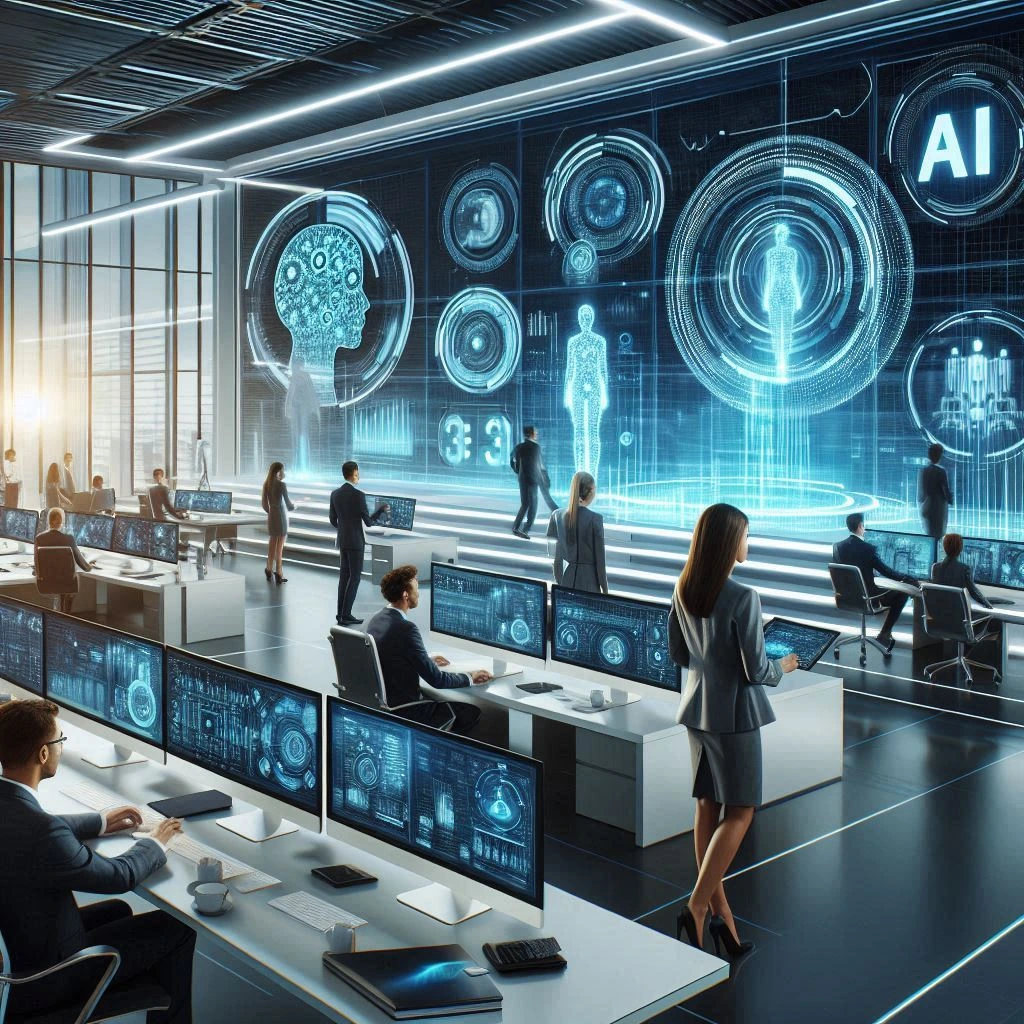Internal audit plays a crucial role in organizations by providing independent assurance that risk management, governance, and internal control processes are functioning effectively. This function is essential for maintaining the integrity of financial reporting, compliance with regulations, and overall organizational performance. As businesses navigate an increasingly complex landscape, the importance of internal audit has never been more pronounced. It serves not only as a safeguard against risks but also as a strategic partner in enhancing operational efficiency and decision-making.
In recent years, the advent of Artificial Intelligence (AI) and automation has begun to reshape the internal audit landscape. These technologies offer innovative solutions that can streamline audit processes, improve accuracy, and enhance the overall effectiveness of audits. By leveraging AI, internal audit teams can analyze vast amounts of data more efficiently, identify patterns and anomalies, and focus their efforts on high-risk areas that require immediate attention. This shift towards automation allows auditors to move away from routine tasks and concentrate on strategic insights that drive value for the organization.
The transformative potential of AI in internal audit processes is significant. It not only enhances the speed and accuracy of audits but also empowers auditors to provide deeper insights into organizational risks and opportunities. As internal audit teams embrace these technologies, they can foster a more proactive approach to risk management, ultimately leading to better decision-making and improved organizational resilience. By integrating AI and automation into their workflows, internal auditors can position themselves as vital contributors to their organizations’ strategic objectives, ensuring that they remain relevant in an ever-evolving business environment.
Understanding AI and Automation in the Context of Internal Audit
As the landscape of internal audit continues to evolve, the integration of artificial intelligence (AI) and automation is becoming increasingly significant. This section aims to clarify the concepts of AI and automation, their relevance to internal audit, and how they are transforming the profession.
AI and Machine Learning Concepts Relevant to Internal Audit
- Artificial Intelligence (AI) refers to the simulation of human intelligence in machines programmed to think and learn. In the context of internal audit, AI can enhance decision-making by providing insights derived from data analysis, pattern recognition, and predictive analytics.
- Machine Learning (ML), a subset of AI, involves algorithms that enable systems to learn from data and improve their performance over time without explicit programming. This capability is particularly useful in internal audit for identifying anomalies and trends in financial data, which can indicate potential risks or areas for further investigation [1][11].
Different Types of Automation Used in Internal Audit Processes
- Robotic Process Automation (RPA): This technology automates repetitive and rule-based tasks, such as data entry and report generation. By implementing RPA, internal audit teams can free up valuable time to focus on more strategic activities that require human judgment and expertise [12].
- Audit Automation Tools: These tools leverage AI to streamline the audit process, from planning and execution to reporting. They can automatically gather and analyze data, generate insights, and produce customized executive summaries, enhancing the overall efficiency of the audit function [6].
- Continuous Auditing: This approach utilizes automation to perform audits on a continuous basis rather than at set intervals. By integrating real-time data analysis, internal auditors can identify issues as they arise, allowing for timely interventions and more proactive risk management.
How AI Can Analyze Large Datasets Quickly and Accurately
One of the most transformative aspects of AI in internal audit is its ability to process and analyze vast amounts of data rapidly and with high accuracy. Traditional audit methods often struggle with large datasets, leading to potential oversights and inefficiencies. In contrast, AI-driven tools can:
- Identify Patterns and Anomalies: AI algorithms can sift through extensive datasets to detect unusual patterns or transactions that may indicate fraud or compliance issues. This capability allows auditors to focus their efforts on high-risk areas, improving the effectiveness of audits [15].
- Enhance Predictive Analytics: By analyzing historical data, AI can help internal auditors forecast potential risks and outcomes, enabling more informed decision-making. This predictive capability is crucial for developing strategies to mitigate risks before they materialize [11].
- Improve Accuracy: AI minimizes human error by automating data analysis processes, ensuring that insights derived from the data are reliable and actionable. This increased accuracy is vital for maintaining the integrity of the audit process and supporting organizational decision-making [6].
The integration of AI and automation into internal audit processes is not just a trend but a fundamental shift that enhances efficiency, accuracy, and strategic insight. As internal audit teams embrace these technologies, they position themselves to better navigate the complexities of modern organizational risks and contribute more effectively to their organizations’ success.
Current Challenges in Internal Audit
As internal audit teams navigate an increasingly complex business landscape, they encounter several challenges that hinder their effectiveness and efficiency. The integration of artificial intelligence (AI) and automation presents a promising solution to these issues. Below are some of the common challenges faced by internal audit teams, the limitations of traditional audit methods, and the pressing need for enhanced decision-making capabilities.
Common Issues Internal Audit Teams Face
- Resource Constraints: Many internal audit departments operate with limited resources, including personnel and budget. This scarcity often leads to an inability to conduct thorough audits, resulting in missed risks and compliance issues. The reliance on manual processes can further exacerbate these constraints, as auditors may struggle to keep up with the demands of their roles [1].
- Data Overload: The volume of data generated by organizations today is staggering. Internal auditors are tasked with analyzing vast amounts of structured and unstructured data to identify risks and ensure compliance. However, the sheer volume can be overwhelming, making it difficult to extract meaningful insights. Traditional methods often fall short in efficiently processing and analyzing this data, leading to potential oversights [3][6].
Limitations of Traditional Audit Methods
- Inefficiency in Data Analysis: Traditional audit methods typically involve manual data collection and analysis, which can be time-consuming and prone to human error. This inefficiency limits the ability of auditors to quickly identify anomalies or trends that could indicate risks or compliance issues. As a result, audits may not be as comprehensive or timely as necessary [2][10].
- Reactive Approach: Many internal audit functions still operate reactively, addressing issues only after they arise rather than proactively identifying potential risks. This approach can lead to significant gaps in risk management and control effectiveness, as auditors may not have the tools to anticipate and mitigate risks before they escalate [3].
Need for Enhanced Decision-Making Capabilities
- Strategic Oversight: The evolving business environment demands that internal audit teams provide strategic oversight rather than merely compliance checks. Enhanced decision-making capabilities are essential for auditors to align their activities with the organization’s risk appetite and strategic objectives. AI and automation can facilitate this by providing real-time insights and predictive analytics, enabling auditors to make informed decisions [8].
- Improved Risk Assessment: With the integration of AI, internal auditors can enhance their risk assessment processes. AI technologies can analyze historical data and identify patterns that may not be immediately apparent through traditional methods. This capability allows auditors to focus on high-risk areas and allocate resources more effectively, ultimately improving the quality of audits [6][10].
The challenges faced by internal audit teams, including resource constraints, data overload, and the limitations of traditional methods, highlight the urgent need for enhanced decision-making capabilities. Embracing AI and automation can transform internal audit processes, enabling teams to operate more efficiently and effectively in today’s dynamic business environment.
How AI is Transforming Internal Audit Processes
The integration of Artificial Intelligence (AI) into internal audit practices is revolutionizing the way audits are conducted, providing significant enhancements in efficiency, accuracy, and decision-making. Here are the key ways AI is transforming internal audit processes:
- Automated Data Collection and Analysis: AI technologies facilitate the automation of data collection, allowing auditors to gather and analyze vast amounts of data quickly and accurately. This automation reduces the time spent on manual data entry and enables auditors to focus on more strategic tasks, enhancing overall productivity [4].
- Enhanced Risk Assessment through Predictive Analytics: AI leverages predictive analytics to improve risk assessment processes. By analyzing historical data and identifying patterns, AI can forecast potential risks and vulnerabilities, enabling auditors to proactively address issues before they escalate. This capability enhances the effectiveness of risk management strategies [3][12].
- Continuous Monitoring and Real-Time Insights: AI enables continuous monitoring of audit processes, providing real-time insights into compliance and operational performance. This shift from periodic audits to ongoing assessments allows internal audit teams to respond swiftly to emerging risks and compliance issues, ensuring that organizations remain agile in a rapidly changing environment [5].
- Streamlined Reporting Processes and Improved Compliance: The use of AI in reporting processes simplifies the generation of audit reports, making them more comprehensive and easier to understand. AI tools can automatically compile data and generate insights, which not only saves time but also enhances the accuracy of compliance reporting. This improvement is crucial for maintaining regulatory standards and ensuring organizational accountability [6][10].
The adoption of AI in internal audit processes is not just a trend but a fundamental shift that enhances the capabilities of audit teams. By automating routine tasks, improving risk assessment, enabling continuous monitoring, and streamlining reporting, AI empowers internal auditors to focus on higher-value activities, ultimately leading to better decision-making and stronger organizational governance.
Enhancing Decision-Making with AI-Driven Insights
The integration of artificial intelligence (AI) into internal audit processes is revolutionizing how organizations approach decision-making. By harnessing the power of AI, internal audit teams can transform complex data into actionable insights, enabling them to make informed decisions that enhance risk management and operational efficiency. Here are some key points illustrating how AI is enhancing decision-making in internal audits:
- Actionable Insights from Complex Data: AI excels at analyzing vast amounts of data quickly and efficiently. By employing machine learning algorithms, internal audit teams can sift through complex datasets to identify patterns and trends that may not be immediately apparent. This capability allows auditors to derive actionable insights that inform strategic decision-making, ultimately leading to improved audit quality and effectiveness [1][2].
- Real-Time Risk Assessment and Anomaly Detection: One of the most significant advantages of AI in internal audits is its ability to conduct real-time risk assessments. AI-powered tools can continuously monitor transactions and operations, flagging anomalies and potential fraud as they occur. This proactive approach enables organizations to address risks promptly, reducing the likelihood of financial losses and compliance issues [3]. For instance, MindBridge’s internal audit software utilizes machine learning to scrutinize every transaction, identifying risks and anomalies that require further investigation.
The future of internal audit lies in embracing AI and automation. By providing actionable insights, enabling real-time risk assessments, and showcasing successful case studies, organizations can enhance their decision-making processes and drive greater value from their internal audit functions. As CIOs and internal audit teams look to the future, leveraging AI will be essential for navigating the complexities of modern business environments and ensuring robust risk management practices.
Best Practices for Implementing AI in Internal Audit
As organizations increasingly recognize the transformative potential of artificial intelligence (AI) and automation, internal audit teams are uniquely positioned to leverage these technologies to enhance their processes and decision-making capabilities. Here are some best practices for implementing AI in internal audit:
- Assess the Current Audit Environment: Before integrating AI, it is crucial for internal audit teams to conduct a thorough assessment of their existing audit environment. This involves identifying specific areas where AI can add value, such as risk assessment, fraud detection, and task automation. Understanding the current processes will help pinpoint inefficiencies and opportunities for improvement, allowing teams to tailor AI solutions effectively [2][10].
- Choose the Right Tools and Technologies: Selecting appropriate AI tools and technologies is essential for successful implementation. Internal audit teams should evaluate various AI solutions that align with their specific audit needs and objectives. This may include tools for data analytics, machine learning, and automation that can enhance the quality and efficiency of audit processes [9].
- Train Internal Audit Staff: To maximize the benefits of AI, it is vital to invest in training for internal audit staff. This training should focus on AI technologies and methodologies, ensuring that team members are equipped with the necessary skills to utilize these tools effectively. A well-trained team can better understand AI’s capabilities and limitations, enabling them to complement their core competencies rather than replace them [4][5].
- Establish a Framework for Ethical AI Use: As AI becomes more integrated into audit processes, establishing guidelines for ethical AI use is paramount. Internal audit teams should develop a framework that ensures transparency, accountability, and fairness in AI-driven decisions. This includes defining roles and responsibilities for stakeholders involved in the AI governance process, which helps create a transparent and accountable system [1][8].
By following these best practices, internal audit teams can effectively embrace AI and automation, leading to improved efficiency, enhanced decision-making, and a more proactive approach to risk management. The future of internal audit lies in the strategic integration of these technologies, setting new benchmarks for effectiveness and operational excellence [12][15].
Future Trends in Internal Audit and AI
The landscape of internal audit is undergoing a significant transformation, driven by advancements in artificial intelligence (AI) and automation. As organizations increasingly adopt these technologies, the future of internal audit is poised for remarkable changes that will enhance decision-making and operational efficiency. Here are some key trends to consider:
1. Emerging Technologies Impacting Internal Audit
- Blockchain Technology: Blockchain offers a decentralized and immutable ledger, which can enhance transparency and traceability in audit processes. This technology can streamline transaction verification and reduce the risk of fraud, making it a valuable tool for auditors [3].
- Advanced Analytics: The integration of advanced analytics allows internal auditors to process and analyze vast amounts of data more efficiently. AI-powered tools can identify patterns, anomalies, and trends that may not be visible to the human eye, thereby improving risk assessment and fraud detection [15]. This capability is crucial as organizations face increasingly complex risk landscapes.
2. Growing Role of Data Governance and Cybersecurity
- As data becomes a central asset for organizations, the importance of data governance in internal audits is escalating. Effective data governance ensures that data is accurate, secure, and compliant with regulations, which is essential for reliable audit outcomes [12].
- Cybersecurity is also becoming a critical focus area for internal audits. With the rise of digital threats, auditors must assess the effectiveness of an organization’s cybersecurity measures. This shift necessitates a deeper understanding of IT risks and controls, making cybersecurity expertise a valuable asset for internal audit teams.
3. Shifts in Audit Roles and Career Paths
- The adoption of AI in internal audit is likely to lead to a redefinition of audit roles. As AI automates routine tasks, auditors will have more time to focus on strategic activities that require specialized expertise. This shift may result in a demand for auditors with skills in data analysis, technology, and risk management [6][14].
- Career paths within internal audit may evolve, with a greater emphasis on technology-driven roles. Professionals who can leverage AI and data analytics will be highly sought after, leading to new opportunities and career advancements in the field [12].
The future of internal audit is intrinsically linked to the integration of AI and emerging technologies. As these advancements reshape traditional practices, internal audit teams must adapt to new roles and responsibilities, ensuring they remain effective in a rapidly changing environment. Embracing these trends will not only enhance decision-making but also position organizations to navigate the complexities of the modern business landscape effectively.
Conclusion
The landscape of internal audit is undergoing a significant transformation, driven by the integration of artificial intelligence (AI) and automation technologies. As organizations increasingly adopt these innovations, the internal audit function is evolving to become more efficient, data-driven, and strategic. Here are the key points to consider:
- Transformative Impact of AI: AI is revolutionizing internal audit processes by automating routine tasks, enhancing data analytics, and improving risk assessment capabilities. This shift allows auditors to focus on higher-value activities, such as strategic decision-making and risk management, ultimately leading to more effective audits and better organizational oversight [1][15].
- Encouragement to Embrace AI and Automation: It is crucial for CIOs and internal audit teams to embrace these technologies. By leveraging AI and automation, organizations can streamline their audit processes, reduce manual errors, and enhance the overall quality of their audits. This proactive approach not only improves efficiency but also positions internal audit as a vital partner in driving organizational success [4][7][13].
- Call to Action: As the future of internal audit unfolds, it is essential for audit leaders to consider how AI and automation can be integrated into their audit strategies. This involves assessing current processes, identifying areas for improvement, and investing in the necessary tools and training to harness the full potential of these technologies. By doing so, organizations can ensure that their internal audit functions remain relevant and effective in an increasingly complex business environment [2][10].
In summary, embracing AI and automation is not just an option but a necessity for internal audit teams aiming to enhance their decision-making capabilities and drive value within their organizations. The time to act is now.
Find out more about Shaun Stoltz https://www.shaunstoltz.com/about/
This post was written by an AI and reviewed/edited by a human.



